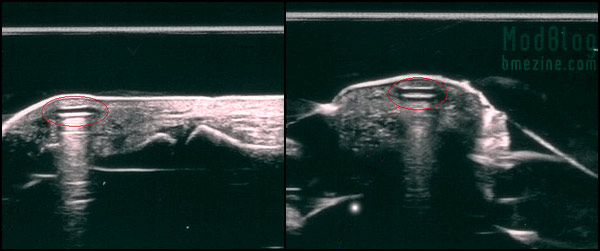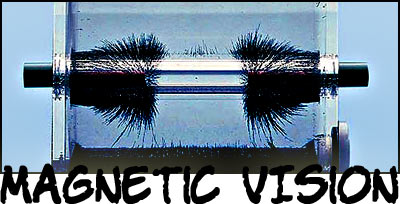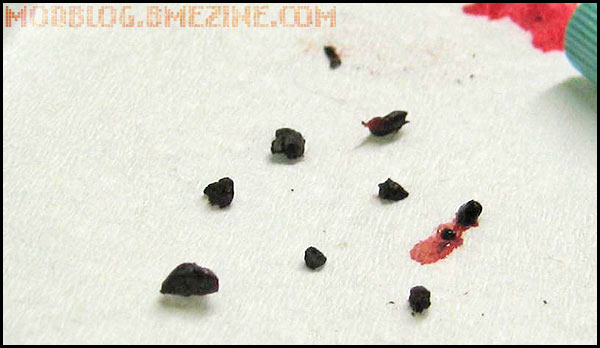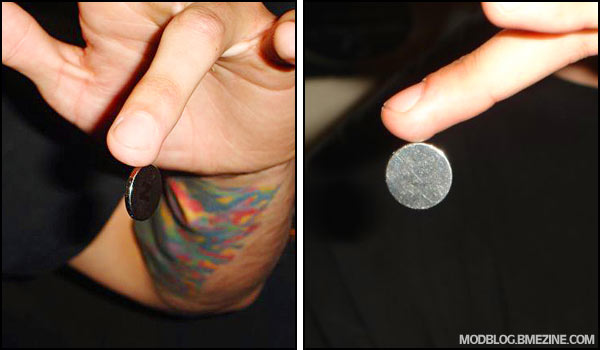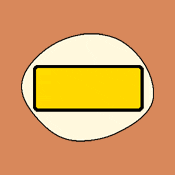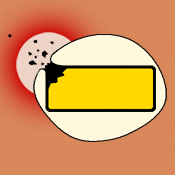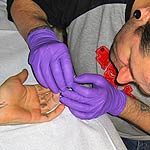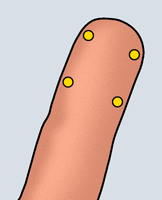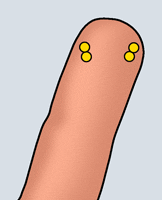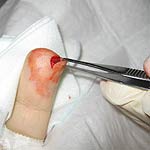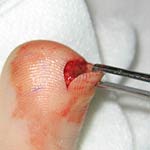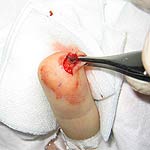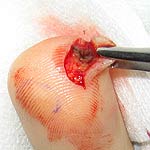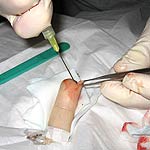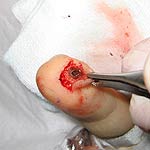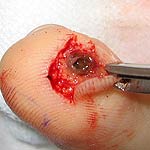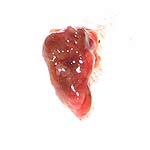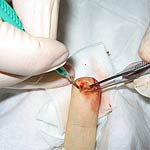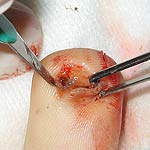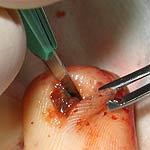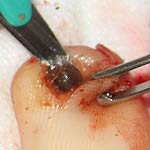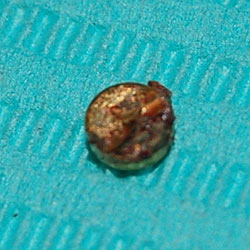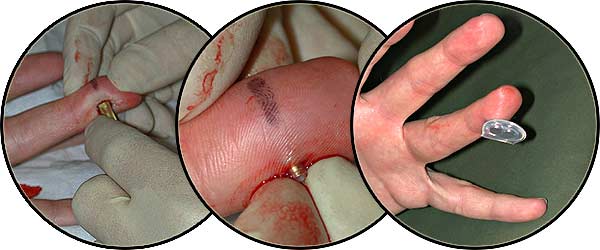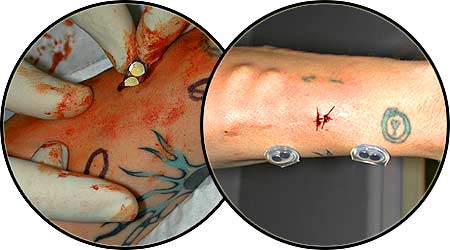
So what’s it like having magnetic vision?
If you don’t already know about magnetic implants, you may want to read our previous articles on the subject, including the original interview about Todd Huffman’s magnets, a six-month retrospective on mine, as well as a magnet risks article with a follow-up by Jesse. In short, magnetic implants are small, encased magnets designed to be implanted in nerve rich areas in order to give the patient heightened sensitivity to EM fields — that is, magnetic vision. Because the magnets vibrate very slightly, the wearer’s senses begin to extend, giving them an awareness of electromagnetic fields and radiation.
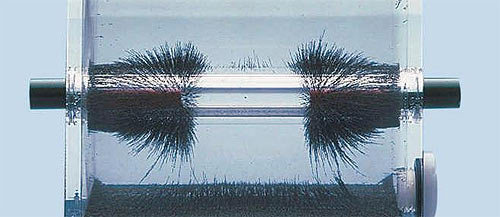
Just like iron filings want to align themselves with a magnetic field, magnetic implants also want to align themselves with magnetic fields. This motion can be felt on an intuitive level by the fine nerves in the fingers, tricking the body into feeling like it’s touching a physical object when it interacts with electromagnetic fields of all sorts.
In this interview I wanted to talk about the “day-to-day” aspect of having implanted magnets — “what’s it like?” Magnetic implants are still quite uncommon, with possibly less than a hundred people having them. We’ll talk to eleven here — in order of when the magnet was implanted, Todd Huffman ([email protected]) had his done in January 2004, a stack of six magnets in a single case, implanted by Steve Haworth and made by Jesse Jarrell (Mr. Bones), who had a silicone case molded 1/16 length X 1/8 dia N45 NIB installed by Steve a few days later. Steve Truitt‘s magnet was self implanted in mid-2005 (and removed about a year later), and my (Shannon’s) magnets were done at about the same time by Steve Haworth. Also by Steve, Quinn Norton‘s magnet, since removed, was implanted in September of 2005. Jymmi‘s magnet was done in September 2006, and Powder‘s was done a month later, both by Steve Haworth. Fred has a 1/16″x1/16″ neodymiuym magnet implant in a custom made titanium casing (all the others here are in silicone), implanted by Nickk Leading. Anton and Dean were both done in January of 2007, and KYO got his most recently, in April 2007.
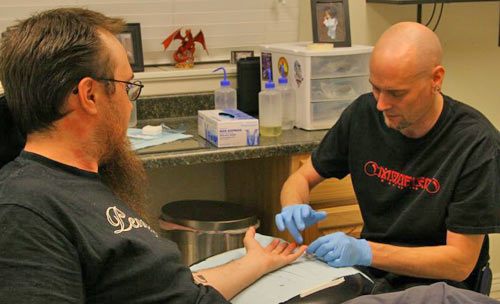
Jymmi having his implant done by Steve Haworth
When and how did you become aware of being able to sense things with your magnetic implant?
Fred: For the first month I thought this was a failure; my main goal was to be able to sense things and I hadn’t sensed anything so far. I work for a company where we manufacture a number of electronic things, and one day my friend was testing a large 230volt power supply with a huge transformer in it so I walked up and waved my hand in front of it and got that cool vibrating sensation in my finger tip. Immediately after I just started putting my finger up to several things I knew had transformers, clocks, cell phone chargers, and microwaves. So far my nebulizer, which I use for my asthma seems to have the strongest field.
Steve It was probably two weeks into having it that I started sensing things. I could feel my microwave stronger than anything.
Jymmi: I could feel small things at about a week to two weeks, like an electric shaver and a one inch earth magnet. After about three or four months I also could feel the electric fields in my non-magnetic hand. It’s not as strong as my magnetic hand — it’s more of a general feeling. About a month ago I started feeling the vibrations in my feet.
Powder: A few days after I had the implant done I was standing in my father’s garage near a large running engine. I felt what I thought was a light breeze on my hand but realised it was only in my implant finger. I started moving my hand closer and farther from the engine and felt slight differences in the sensation.
KYO: On the sixth day I picked up an electric sharpener and had a weird sensation — then I realised it was actually the magnetic implant reacting to the electro magnetic field from the engine.
Jesse: I tried static fields from large magnets fairly immediately after insertion, but the first really astounding sensation was provided by a power drill.
Todd: To quote from my blog, two days after getting the implant:
I experienced my first "in the wild" implant sensory experience. I was in the library checking my e mail, and as I walk out there is an anti theft gate thingy. When I stepped on the pad I felt my implant oscillate, and quite noticeably so. My initial reaction was surprise, since I wasnt consciously paying attention to the implant. After the initial adrenaline rush I walked back and forth through the sensor gate, and it is quite interesting. So far my interactions have been planned, i.e. putting magnets and metal near my implants to see what happened. Todays event was rather significant, it was not planned, nor was it forseen.
Dean: The first thing I noticed was while drinking a can of Coke. The magnets themselves obviously weren’t strong enough to pick the can up, but I could feel a slight sensation when holding the can itself. The best way to describe it is a tingling sensation. To date, I am the only person out of the three i know with the implants to get this with a can.
Quinn: Right after the implant, Steve passed a magnet close to my finger. I felt it move, and jumped. After that I wasn’t sure which sensations were the healing process and which were the magnet, but as time went on, I was able to distinguish more.
Shannon: The first thing I noticed was the drives and fans in my computer. I think I remember a vague buzzing in my fingertips, wondering what it was, and then moving my hands around and realizing that I was sensing definite fields and from that point on it snowballed (although I think they may be becoming less senstive over time — I don’t know if this is due to scarring or demagnetization).
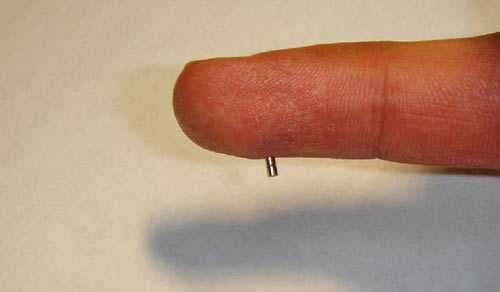
Fred’s magnet picks up another small magnet.
What range of sensation are your magnets capable of?
Anton: I can feel rather faint magnetic fields and also electric currents at times, depending on how strong they are.
Fred: I can’t feel store security poles, but I have felt a metal detector as I walked through — surprisingly it didn’t go off like I thought it would. I have to have my hand less than a foot away from whatever I’m attempting to feel.
Jymmi: I am more sensitive to electrical currents. Sometimes the implant will vibrate or twitch depending on what I walk by. We have these big space heaters at my work, about fifteen to twenty feet up in the air and my whole hand vibrates when those turn on. We also have electric forklifts, and when I get close to the battery chargers it feels like an electric current running up my arm.
Steve: I could sense some electrical currents on certain things, especially larger things like my stove or dryer. I could feel certain types of security sensors at some stores. I was never able to feel anything from my computer though.
Powder: I can feel different amperages in various cables. I can also tell when a metal is a ferous or not. My favorites are the fields around microwaves (a couple of feet out), AC transformers (a few inches), and fans under the keyboards of laptops (about half an inch above and while typing).
KYO: range is hard to define since I find new things on a daily basis. But I’m basicly able to feel the magnetic field around magnets, my computer, some speakers, the oven, some fields around the electric wires (I can actually detect the flaws since the lower protection allows the field to get trough).
Jesse: On the lower end I can feel higher power draws through standard 120v insulated power cords (wall power), various functions inside computer equipment(from a distance), magnetism in the more magnetic alloys, on to stronger things like various components of high voltage equipment used in my machine shop, including insulated high voltage leads from a foot or more away, transformers, motors and magnetrons wherever they may exist, store security devices, the stove, and so on.
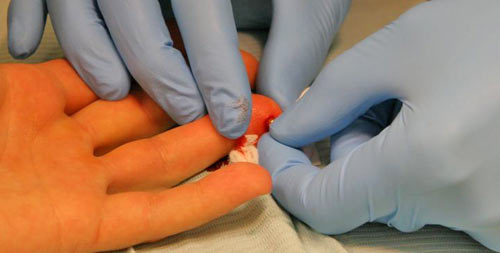
Closeup of Jymmi’s magnetic implant being installed.
Todd: Static fields are pretty uninteresting, and need to be pretty large. Oscillating fields I can sense at much lower amplitudes, and are more interesting because they occur more frequently in the real world for things I find interesting. I’ve never quantified the exact range, but I can sense a current running through an insulated wire if there is enough of it. Whatever a power cable to a hair dryer pulls I can sense, and probably about three quarters of that current.
Dean: The magnets themselves aren’t that strong, although I am able to pick up tiny pieces of metal and can also use them for various magic tricks in conjuction with my magnetic wedding band ring. The most sensation I get though is when walking through magnetic fields — those sensors they have by shop doors. Again it’s like a tingle within my finger, almost like a sixth sense.
Quinn: I felt about three different sensations from my implant. I can’t really describe them very well, but one of them I got consistently from my laptop, and another from electrical cords. The third I felt very rarely… And of course, a fourth: other magnets pulling on my finger. To this day one of the oddest things I have ever felt was the magnet spinning in my finger in response to circling it with another magnet. I tried to practice with it everyday, bring it close to things I thought would be sensable and concentrate on the sensation. After a while it became a comforting and even enjoyable thing. I would pass the magnet over parts of my laptop, and feel them consistently. After a while it helped me feel kind of like all was well with the world. I enjoyed concentrating on the feeling more than I thought I would. I was pleasantly surprised when I would run into unexpected sensations.
Shannon: I can barey feel static magnetic fields unless the field is very powerful (such as a large magnet). Vibrating EM fields ranging from spinning magnets in engines (power tools, the fans and drives in a computer, and so on) to any A/C or otherwise fluctuating electrical fields are very easy to feel. Powerful fields like you find in some security systems (especially the type that need to deactivate tracking tags) can actually be quite painful, but essentially an EM fluctuation is just like a physical vibration. So for example, a power cord will have a “buzzing” halo around it that I can feel without touching the cable itself. The size and tone of this field make it fairly obvious what I’m touching.

Paperclip trick by Powder.
What are some day to day ways you use your magnets?
Anton: I work in a hospital (in the ER) and I can tell if the MRI is in use about fifty feet away from the room. Needless to say, I can’t go in there when it’s on, or it will rip the magnets clean out of my finger — I guess that’s one way to remove them.
Fred: I actually use my magnet quite a lot, mostly just to see if stuff is turned on. I am able to locate transformers inside objects and thus detect if they are on. I work in production where I make tons of different electronic components. It’s fun because Im around a lot of huge transformers so it’s interesting to see how strong each of them are. I found a magnet under my bed once by feel alone, even though I wasn’t even looking for that and couldn’t see it.
Jymmi: I like to walk around work or through a store or just from room to room in my house and find different places that give off electric feilds — like air conditioners, tattoo machines, and refrigerators. I use my laptop everyday and there are still a lot of fields that I can’t figure out where they are coming from — the disc drive is kind of going bad and everytime it spins trying to read discs it puts off a crazy field. There is a small field around the steering wheel on my car — I can’t figure out if it’s from the metal vibrating. or if there is a magnet somewhere in there. Some cars have it, some don’t.
Steve: I didn’t really have any day to day uses other than just being able to sense things. Now that it’s been out for over a year, I can still sense the same magnetic feilds, just not as strongly.
Powder: I have used it to find hot cables in a bundle, and sometimes use it to test reed switches in some of the electronics I repair.
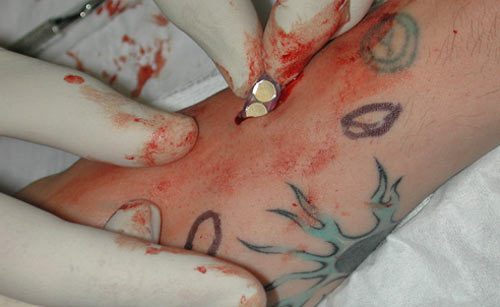
Jesse’s magnets being installed.
KYO: Working at McD, there are the fries that beep once the cooking is completed, and the magnet allow me to know about a second ahead that they will beep since there is a diffrent field that appears to make the alarm go on. Also, my imitation iPod tends to turn off by itself or simply go on pause, and the magnet allows me to know if it’s on or not without taking it out of my pocket. My cellphone is on vibrate, and I’m never sure if it’s my cell or not, but by holding my finger about half an inch away, I can tell for sure if it’s actually the cell that’s ringing. Finally I had used my magnet to troubleshoot a laptop, being able to detect something strange under the keyboard, and the tech did change a card that was located exacly in the area I had spotted the irregularities.
Jesse: Immediate awareness of high voltage is very comforting in a lot of ways — there is a reasonable amount of it around me in the shop where I live. Determination of ferrous alloys is frequently handy without having to go look for a magnet. Circuit tracing inside various equipment is often aided by it. Common shop dialogue: unenhanced individual: “Hey, what the hell is thing I pulled off that old assembly line?” enhanced individual: “I don’t know, but its got magnets inside the case here, here and here, I’m guessing the two along that guide rod are for positional sensing, and the one over here is probably a transformer.”
An interesting note is that I sometimes get “noise” from it — moving fields with no apparent source. Some of it may be the magnet just “righting” itself after being moved by a previous field or physical force and slowly settling back into a position that fits better with the tissues in my finger, but there have been a few occasions that were not so easily explained away, where I sensed apparent moving fields in open air with no visible source.
Todd: Occassionally I use it for diagnostics. For instance, in airports often the power plugs on the walls don’t have power, and I can test them out by just plugging in my power adaptor and feeling for the field — I don’t have to get my computer out. One time I was trouble shooting a water pump, and I could tell that the motor component was working just by feeling the fields, letting me know that the problem was with the pump-shoe thingy. I can also feel my laptop’s hard drive stepper motors, and I like knowing when my computer is moving out of RAM and dropping down into the HD for info.
Dean: I usally get most of my day to day use out of the magnet when going in and out of stores. It also helps to tell when certain things are turned on if there no other signs to tell you so. Like my computer monitor… the standby light has broke, but I am able to tell if it’s on standby of not by placing my hand on the screen. Then again though, it really is an old messed up screen. I really should replace it.
Quinn: A couple times, in determining if something was live or not. Once, I was able to work out that a demo wasn’t realistic based on the sensation from a cord.
Shannon: I’m very aware of power, so for example it’s easy to tell if something is plugged in because I can feel the power leaking out of the extension cord (and I can tell how much power is being drawn — and also tell the quality of the cable assuming there’s a frame of refernece). In day-to-day life, my electric stove has bad connections in some of the burners, so the amount of heat that a given dial-setting generates is different from day to day. Now, instead of using the dial, I just hold my hand an inch or two over the burner and “feel” for the right setting by sensing the amount of power that’s leaking off the coil. It’s actually quite fascinating how EM-saturated our environment is.
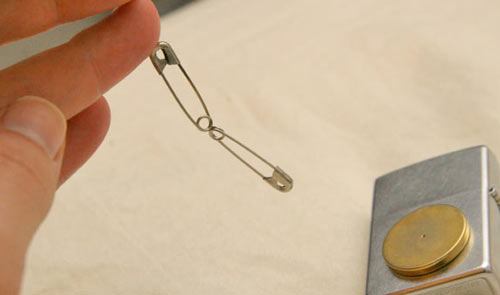
Jymmi’s powerful magnet picking up a couple of safety pins.
Does your magnet have functional (as in non-sensation) uses?
Fred: Sadly, I am only able to pick up other magnets and only small things like staples.
Anonymous: I’ve gotten laid a number of times directly attributable to the implant. Occasionally a girl on the fringe of my social group will be all like “are you the guy who put a magnet in his finger?” (swoon).
Anton: I can pick up very small, very light objects, and move the compass on my keychain — it’s great for bar tricks.
Jymmi: The most I can do is pick up screws, paper clips, and bottle caps — or spinning lighters. It really freaks people out when they hold your finger and you move the implant around with another magnet they can feel it moving around under the skin.
Steve: It didn’t hvae any functional uses for me, other than some “party trick” type stuff like picking up paper clips or things like that.
Powder: I use my magnet to pick up small screws I might drop while working on various electronics. I have used it to single out a cable in a bundle of cables. I mostly use it to do small magic tricks like playing with my compass or rolling other magents around without touching them. When I’m bored I’ll play by swinging a paperclip back and forth.
Todd: It has functional use in that it helps me reconceptualize the world around me, and every now and then I say something smart, and that is what people pay me to do. I got into my PhD program solely because of the implant. I was at a conference and some dude was all like, ‘there’s this dude who put a magnet in his finger’ and I was like ‘oh thats me’ and he was like ‘no, really’, and I was like ‘no really’. Then he made arrangements for me to get into my PhD program. Which I promptly dropped out of for sociopolitical reasons but it was pretty cool at the time.
Dean Newman I suppose the most use i get out of the magnets again would be when using with magic. Stopping a compass, or sometimes even a watch although that is a lot harder. After a while i was able to use it to “palm” certain objects although nothing bigger than a paperclip.
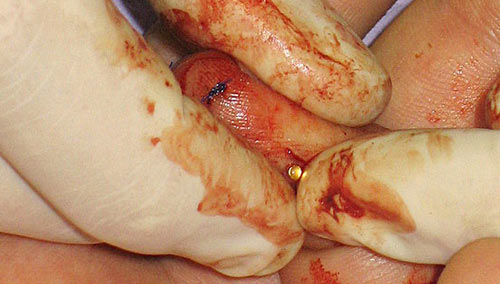
Shannon’s silicone-dipped magnetic implants being placed.
Why do you think some people report magnetic sensations without the magnet? (Both in new areas, and after removal)
Jymmi: I’ve been wondering if you need to have the implant to feel the electric field — if you can train your body to feel it without the implant. It would probably explain why I can feel it in both hands and feet, or maybe i’m just a freak. I think it is real. I’m not sure if it’s nerve density or something biological like high iron in the blood?
Todd: I sometimes percieve the magnetic sensation in two fingers, my left ring and pinkie fingers. However, I only have the impant in my left ring finger. I’ve thought about this phenomenon, and here is what I have believe is occuring. In the course of normal finger operation your pinkie and ring fingers often percieve things in parallel. For instance when you grab an ass or run your hands down a woman’s back those two fingers are feeling pretty much the same thing. Your nervous system has limited resources for transmitting information, and uses clever tricks to up the amount of information processing per calorie. Since those two fingers often run in parrallel, at some point for efficiency the nervous system constructed a compression algorithm. The dual finger perception with only one implant is an artifact of that compression. The phenomenon isn’t 100% consistent, I’d estimate 10% of the sensations come up dual.
Shannon: I can’t currently sense EM fields in any place other than the fingertip that contains the magnet stack (and the ones that have been removed don’t appear to retain any sesnation), and don’t have any “crossover” between fingers.
Quinn: I suspect this is a matter of learning to concentrate. Before I went to Phoenix I designed a test just to make sure it was real, picking out a live wire from 4 choices. We did it double blind back in California with unmodified controls. People actually could pick out the live cord better than the stats would have had it. When I sat down to try it, I could pick out a live cord about 80% of the time, about twice the other controls. We were all surprised, but after talking to some people that worked with electronics, it turned out this was not at all unique. I think it’s entirely reasonable to think that learning to concentrate on AC would let you do it with your skin even without a magnet; though not as reliably. We are, after all, conductive.
Please note that magnetic implants are still highly experimental and the underlying encasement technologies and so on are not yet mature. If you want one, please be sure to research and understand the risks in advance!
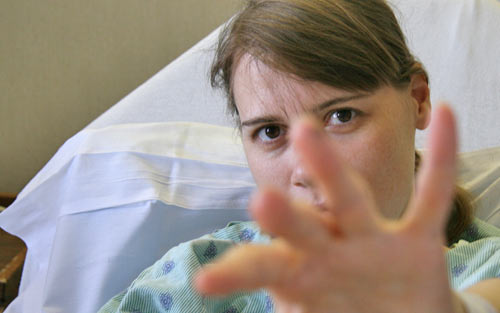
Quinn’s implant (note the discoloration) just before removal.

Shannon Larratt
BME.com
|
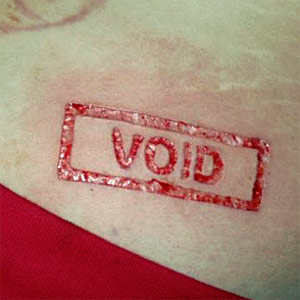 I wanted to share with you a remarkable conversation I had with a friend of mine who works as a nurse in a hospital. She also has a magnetic implant in her fingertip, and the ability to sense electromagnetic fields that comes with it. This may be the best example I’ve heard to date of the real-world value of magnetic vision, illustrating that it’s not “just a neat trick”.
I wanted to share with you a remarkable conversation I had with a friend of mine who works as a nurse in a hospital. She also has a magnetic implant in her fingertip, and the ability to sense electromagnetic fields that comes with it. This may be the best example I’ve heard to date of the real-world value of magnetic vision, illustrating that it’s not “just a neat trick”.
